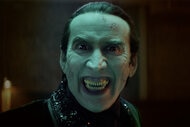Shadow and Bone: How the Netflix series diversified the Grishaverse novels for the better

Television and film adaptations of popular book series don't just give the works they're based on a new life. They also offer those working on it a chance to build on the characters and themes within, ideally for the better. In the case of Netflix's Shadow and Bone, the upcoming adaptation of author Leigh Bardugo's bestselling "Grishaverse" books, this meant creating a more inclusive world that reflects one a modern audience is more used to, and that meant casting more diversely.
"There's a kind of weird idea that an inclusive or diverse cast is somehow artificial or contrived," Bardugo, who is also an executive producer on the series, told SYFY WIRE and other members of the press ahead of the series' April 23 premiere. "And I find that very weird because our world does not look straight and white, and there's no reason that a fantasy world should look straight and white."
Shadow and Bone tells the story of Alina Starkov (Jessie Mei Li), an orphaned mapmaker from the kingdom of Ravka who discovers that not only is she a Grisha — people with the special ability to manipulate elements of the world around them — but she's specifically a "Sun Summoner," a Grisha with the power to call upon sunlight. When her powers are discovered, her fellow Ravkans hope it means she can pierce through the "Shadow Fold," a tall wall of pitch darkness that cleaves Ravka into two halves, preventing anyone from crossing through. The series also threads in characters from Bardugo's spin-off duology, Six of Crows, as the trio of Kaz Brekker (Freddy Carter), Inej Ghafa (Amita Suman), and Jesper Fahey (Kit Young) set off on a parallel mission of their own.
Since the publication of Shadow and Bone — the first book in the trilogy of the same name — in 2012, Bardugo has strived to make the world of her books more inclusive. This is most reflected in Six of Crows, in which character's races were more explicitly stated and half the cast of the book was made up of characters of color. Two of them, Jesper and Inej, even take center stage in the TV series. Bardugo's even used her most recent duology, King of Scars, to flesh out some of the recurring characters from her previous books' identities more.
"When I wrote Shadow and Bone, I was echoing a lot of the fantasy that I had loved growing up," Bardugo says. "But as I became more confident as a writer, I started writing it more honestly, more realistically, and I created a more believable world that was necessarily a more diverse world. So I thought that was something that the show could get better from moment one."
This led to one of the biggest changes in the jump from the page to the small screen: making Alina half Asian — or within the context of the show, "half Shu," as Shu Han, one of the kingdoms warring with Ravka, is based on China — rather than white and casting accordingly. As a result, the Alina we see on screen is an outsider in more than one way, making her search for a home and her desire to fit in all the more meaningful and adding an extra layer to her character.
"Alina spent her whole life being told she looks like the enemy, so she's had to stand up for herself and grow this thick skin," Jessie Mei Li, who like her character is also biracial, says. "But she's also so vulnerable and she's so suspicious of new people. She speaks softly because she doesn't want anyone to feel that she's aggressive."
But casting diversely is just one piece of the puzzle when creating a more inclusive world, as race can inform a lot about a character and who they are as a person, as well as how they move about the world. This is best seen in Zoya Nazyalenski (Sujaya Dasgupta), a Grisha and one of General Kirigan's (Ben Barnes) favorite soldiers. From the start, Zoya views Alina as a rival despite how much they have in common: Much like Alina, Zoya is also biracial, only she's half Suli — not that it dampens her fierce loyalty to Ravka.
"She's a very complicated character because although she is very aware of her identity and her race and where her parents come from," Dasgupta says, noting that Zoya has probably had experiences similar to that of Alina's. "She will also use it as a dig or a means to hurt Alina because she knows, as another mixed-race woman, these things hurt."
The team behind the show, which includes Bardugo and showrunner/executive producer Eric Heisserer (Arrival), also sought to make the world more layered in ways that are less obviously visible right away. Jesper gets to explore his attraction to men more openly while Kaz's use of his cane is prominently featured throughout the episodes.
"I was really adamant to make Kaz's limp and his use of the cane feel very embodied," says Carter, who didn't have as much physical training to do for his role on account of his character's disability, though Carter himself doesn't walk with the help of a cane. "That helped feed into the psychological side of [him, and his] dogmatic, 'always keep going to find the next solution or solve the next problem' type of attitude."
Even with as many successful changes as the show was able to make in its first season while still building out its expansive world and telling the story of Bardugo's novels, both the author and Heisserer feel they've only just gotten started on this front.
"You make progress one step at a time," Heisserer says. "I feel like there's a lot more do so that if, knock wood, we get a chance to return in Season 2, hopefully, you'll get to see even more of it."
Shadow and Bone premieres on Netflix on April 23.





























